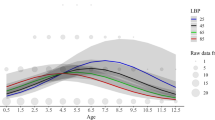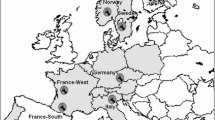Abstract
I examined the reproductive status of female brown mouse lemurs (Microcebus rufus) from October 2005 to early January, 2006 at Ranomafana National Park, an eastern rain forest in Madagascar. I employed intensive capture/mark/recapture techniques to track individual changes in vaginal morphology and body mass and collected vaginal smears for individuals with open vaginas. I observed moderate estrous synchrony (vaginal openings between October 11 and November 18), with clusters of females showing strong estrous synchrony (6 of 15 on or around October 15, and 3 of 15 on or around October 25). My findings weakly support the proximity hypothesis—that closer females will enter estrus simultaneously—and offer virtually no support for the notion that body mass influences the timing of estrus in brown mouse lemurs. Females gave birth during the second and third weeks of December. Two females showing signs of abortion or perinatal death of offspring also showed renewed vaginal swelling in late December, suggesting that some form of polyestry, i.e., as reproductive compensation for infant loss, exists at Ranomafana. I discuss the implications of the data, in conjunction with other evidence of polyestry in wild mouse lemurs, in light of data on patterns of seasonality at Ranomafana and other sites. More data are needed to determine the frequency and pattern of polyestry in Microcebus rufus.






Similar content being viewed by others
References
Atsalis, S. (1999). Seasonal fluctuations in body fat and activity levels in a rain-forest species of mouse lemur, Microcebus rufus. International Journal of Primatology, 20, 883–910.
Atsalis, S. (2000). Spatial distribution and population composition of the brown mouse lemur (Microcebus rufus) in Ranomafana National Park, Madagascar, and its implications for social organization. American Journal of Primatology, 51, 61–78.
Atsalis, S. (2007). A natural history of the brown mouse lemur. Upper Saddle River, NJ: Prentice-Hall.
Brockman, D. K., & van Schaik, C. P. (2005). Seasonality and reproductive function. In D. K. Brockman, & C. P. van Schaik (Eds.), Studies of living and extinct human and non-human primates (pp. 269–305). New York: Cambridge University Press.
Buesching, C. D., Heistermann, M., Hodges, J. K., & Zimmermann, E. (1998). Multimodal oestrus advertisement in a small nocturnal prosimian, Microcebus murinus. Folia Primatologica, 69(Suppl 1), 295–308.
Dammhahn, M., & Kappeler, P. M. (2005). Social system of Microcebus berthae, the world's smallest primate. International Journal of Primatology, 26, 407–434.
Eberle, M., & Kappeler, P. M. (2004a). Sex in the dark: determinants and consequences of mixed male mating tactics in Microcebus murinus, a small solitary nocturnal primate. Behavioral Ecology and Sociobiology, 57, 77–90.
Eberle, M., & Kappeler, P. M. (2004b). Selected polyandry: Female choice and inter-sexual conflict in a small nocturnal solitary primate (Microcebus murinus). Behavioral Ecology and Sociobiology, 57, 91–100.
Felsenstein, J. (1985). Phylogenies and the comparative method. American Naturalist, 125, 1–15.
Glatston, A. R. H. (1979). Reproduction and behavior of the lesser mouse lemur (Microcebus murinus, Miller, 1777) in Captivity. Ph.D. dissertation, University College, London.
Goodman, S. M., Langrand, O., & Raxworthy, C. J. (1993a). Food habits of the Madagascar long-eared owl Asio madagascariensis in 2 habitats in Southern Madagascar. Ostrich, 64, 79–85.
Goodman, S. M., Langrand, O., & Raxworthy, C. J. (1993b). The food habits of the barn owl Tyto alba at 3 sites on Madagascar. Ostrich, 64, 160–171.
Heideman, P. D., & Utzurrum, R. B. (2003). Seasonality and synchrony of reproduction in three species of nectarivorous Philippines bats. BMC Ecology, 3, 11.
Lahann, P., Schmid, J., & Ganzhorn, J. U. (2006). Geographic variation in populations of Microcebus murinus in Madagascar: Resource seasonality or Bergmann's rule? International Journal of Primatology, 27, 983–999.
Lebec, A. (1984). Relation entre le comportement agressif du Microcèbe mâle, les autres comportements et la physiologie sexuelle. Rôle de quelques facteurs déterminants. Thèse 3ème cycle, University of Paris VI.
Perret, M. (1982). Influence du groupement social sur la reproduction de la femelle de Microcebus murinus (Miller, 1777). Zeitshrift für Tierpschychologie, 60, 47–65.
Perret, M. (1986). Social influences on oestrous cycle length and plasma progesterone concentrations in the female lesser mouse lemur (Microcebus murinus). Journal of Reproduction and Fertility, 77, 303–311.
Perret, M. (1992). Environmental and social determinants of sexual function in the male lesser mouse lemur (Microcebus murinus). Folia Primatologica, 59, 1–25.
Perret, M. (2005). Relationship between urinary estrogen levels before conception and sex ratio at birth in a primate, the gray mouse lemur. Human Reproduction, 20, 1504–1510.
Perret, M., & Aujard, F. (2001). Regulation by photoperiod of seasonal changes in body mass and reproductive function in gray mouse lemurs (Microcebus murinus): Differential responses by sex. International Journal of Primatology, 22, 5–24.
Prendergast, B. J. (2005). Internalization of seasonal time. Hormones and Behavior, 48, 503–511.
Radespiel, U., & Zimmermann, E. (2001). Dynamics of estrous synchrony in captive gray mouse lemurs (Microcebus murinus). International Journal of Primatology, 22, 71–90.
Radespiel, U., & Zimmermann, E. (2003). The influence of familiarity, age, experience and female mate choice on pregnancies in captive grey mouse lemurs. Behaviour, 140, 301–318.
Randrianambinina, B., Rakotondravony, D., Radespiel, U., & Zimmermann, E. (2003). Seasonal changes in general activity, body mass and reproduction of two small nocturnal primates: A comparison of the golden brown mouse lemur (Microcebus ravelobensis) in Northwestern Madagascar and the brown mouse lemur (Microcebus rufus) in Eastern Madagascar. Primates, 44, 321–331.
Schmelting, B., Ehresmann, P., Lutermann, H., Randrianambinina, B., & Zimmermann, E. (2000). Reproduction of two sympatric mouse lemur species (Microcebus murinus and M. ravelobensis) in north-west Madagascar: First results of a long term study. In W. R. Lourenço, & S. M. Goodman (Eds.), Diversité et Endémisme à Madagascar (pp. 165–175). Paris: Memoires de la Société de Biogéographie.
Schmid, J., & Kappeler, P. M. (1998). Fluctuating sexual dimorphism and differential hibernation by sex in a primate, the gray mouse lemur (Microcebus murinus). Behavioral Ecology and Sociobiology, 43, 125–132.
Whitten, P. L., & Brockman, D. K. (2001). Strepsirrhine reproductive ecology. In P. T. Ellison (Ed.), Reproductive ecology and human evolution (pp. 321–350). New York: Aldine de Gruyter.
Wright, P. C. (1992). Primate ecology, rainforest conservation and economic development: Building a national park in Madagascar. Evolutionary Anthropology, 1, 25–33.
Wright, P. C. (1999). Lemur traits and Madagascar ecology: Coping with an island environment. Yearbook of Physical Anthropology, 42, 31–72.
Wright, P. C. (2006). Considering climate change effects in lemur ecology and conservation. In L. Gould, & M. Sauther (Eds.), Lemurs: Ecology and adaptation (pp. 387–404). New York: Springer.
Wright, P. C., & Andriamihaja, B. (2002). Making a rain forest national park work in Madagascar: Ranomafana National Park and its long-term research commitment. In J. Terborgh, C. van Schaik, M. Rao, & L. Davenport (Eds.), Making parks work: Strategies for preserving tropical nature (pp. 112–136). Washington DC: Island Press.
Wrogemann, D., Radespiel, U., & Zimmermann, E. (2001). Comparison of reproductive characteristics and changes in body weight between captive populations of rufous and gray mouse lemurs. International Journal of Primatology, 22, 91–108.
Wrogemann, D., & Zimmermann, E. (2001). Aspects of reproduction in the eastern rufous mouse lemur (Microcebus rufus) and their implications for captive management. Zoo Biology, 20, 157–167.
Acknowledgments
This project would not have been possible without the help of many people, particularly Laurie Godfrey, who provided advice at every stage. I thank Anja Deppe for her collaboration with mouse lemur research as well as Patricia Wright for advice and support in the field. Additional thanks go to my local (Centre ValBio-trained) research assistants, Victor Rasendrinirina and Jean Claude Rakotonirina, at Ranomafana; the Centre ValBio director Anna Feistner, Jean Claude Razafimahaimodison; and Aimée Razafiarimalala and other personnel of the Centre ValBio for logistic support. Staff from the Association Nationale pour la Gestion des Aires Protégées (ANGAP), the Institute for the Conservation of Tropical Environments (ICTE, Stony Brook), and the Madagascar Institute pour la Conservation des Ecosystèmes Tropicaux, (MICET), especially its director, Benjamin Andriamihaja, facilitated the research at Madagascar. I thank Rafael Fissore, Michael Bedford, and Kay Izard for technical assistance and Stacy Gebo for assistance in taking the photographs. I thank Cathy Williams and Jeff Wyatt for veterinary advice. I also greatly appreciate comments on an earlier draft of the manuscript by Sylvia Atsalis, Diane Brockman, Stephen King, Lynnette Sievert, and Patricia Wright, as well as 2 anonymous reviewers. I wrote the article under the support of a National Geographic Society Grant to Laurie Godfrey.
Author information
Authors and Affiliations
Corresponding author
Rights and permissions
About this article
Cite this article
Blanco, M.B. Reproductive Schedules of Female Microcebus rufus at Ranomafana National Park, Madagascar. Int J Primatol 29, 323–338 (2008). https://doi.org/10.1007/s10764-008-9238-9
Received:
Revised:
Accepted:
Published:
Issue Date:
DOI: https://doi.org/10.1007/s10764-008-9238-9




